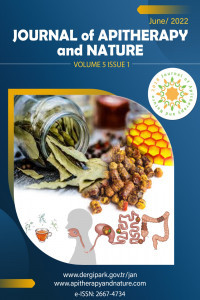Qualitative Analysis and Biological Evaluation of Propolis from Armenia and Georgia
Qualitative Analysis and Biological Evaluation of Propolis from Armenia and Georgia
Biological Evaluation, Propolis, GC/MS,
___
- 1. Popova Μ., Chinou Ι., Marekov Ι. and Bankova V. (2009). Terpenes with antimicrobial activity from Cretan propolis. Phytochemistry, 70: 1262-1271.
- 2. Bankova V., de Castro S.L. and Marcucci M.C. (2000). Propolis: recent advances in chemistry and plant origin.Apidologie 2000, 31, 3-15.
- Yayın Aralığı: Yılda 2 Sayı
- Başlangıç: 2018
- Yayıncı: Oktay YILDIZ
“Green” Synthesis of Gold and Silver Nanoparticles with Propolis Extract and Rosa damascena Waste
Anton M. SLAVOV, Daniela KARASHANOVA, Biliana GEORGIEVA, İvelina VASILEVA, Vassya BANKOVA, Rada DINKOVA, Nikoleta YANTCHEVA
Chemical Profile of Greek Arbutus unedo Honey – Biological Properties
αrgyrο ANDREOU, Ioanna CHINOU, Konstantia GRAIKOU
Chemical Profiling of Papua New Guinea Propolis and Assay its Antiprotozoal Activity
Samya ALENEZI, Naif Alenezi MANAL, J NATTO, Harry P. De KONING, John IGOLI, David G. WATSON
Toothpaste with Propolis “Apident” Shows Antimicrobial Activity in vitro
Klemen RIHAR, Dunja Gregorič EXEL, Adriana PEREYRA, Rok KOPINČ, Bratko FILIPIČ
Water Extract of Propolis Might be Safer to Use During Pregnancy than Ethanol Extract
Al Mukhlas FIKRI, Ahmad SULAEMAN, Sri Anna MARLIYATI, Mokhamad FAHRUDIN
Carmen Violeta POPESCU, Hazem ABBAS, Stefan MANEA, Lili IVOPOL, Alina DUNE, Candice POPINIUC, Dumitru LUPULEASA
María Inmaculada GONZÁLEZ-MARTÍN, Eddy Valentín BETANCES-SALCEDO, Isabel REVILLA, Ana María VIVAR-QUINTANA
Formulations Containing Propolis of Apis mellifera with Antibacterial and Antitumoral Activity
G.a. DOS SANTOS, A.a. LAGAREIRO NETTO, P.b. MENDES, V. NEGRÃO, M.C. MARCUCCI, S.N. DINIZ, M.J. CARNEIRO, A.C.H.F. SAWAYA
Mihaela NICULAE, Laura STAN, Adriana URCAN, Timea DOMOKOS, Daniel S. DEZMIREAN, Otilia BOBIS
İbrahim PALABIYIK, Didem SOZERI ATIK, Esra BOLUK, Sevgi KOLAYLI
